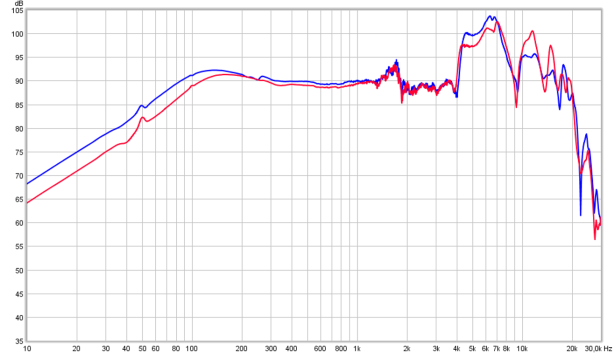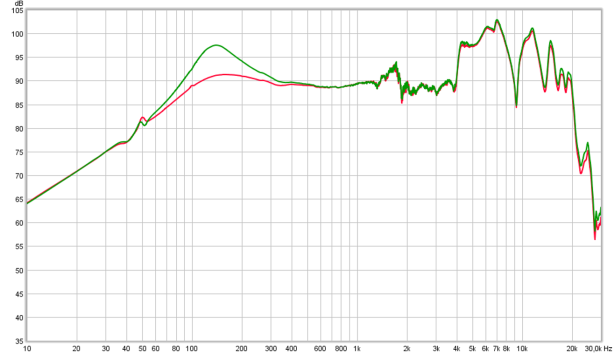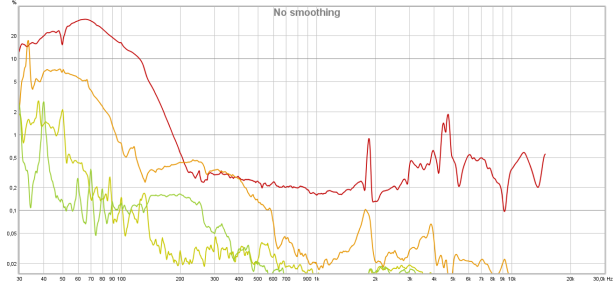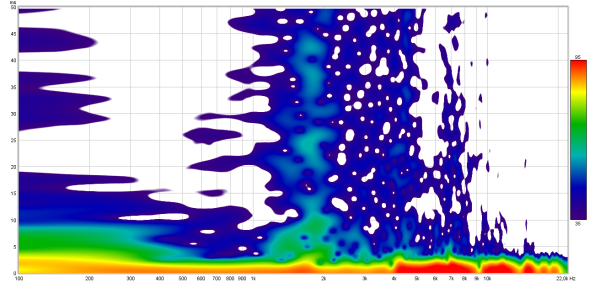GS2000e
back to Grado
back to measurements
home
published: Oct-29-2017, updated: Jan-6-2022
NO SMOOTHING is applied to the shown plots. Most measurement sites have some smoothing applied which ‘irons flat’ sharp peaks and ‘wiggles’. I do not use smoothing because some info about sound quality is lost when plots are smoothed.
Aside from a small correction of the microphone itself also some correction in the lowest frequencies is applied to the plots to compensate for the perceived loss of bass when using headphones. This is described HERE in more detail.
A ‘horizontal‘ frequency response curve on the shown frequency response plots on this website thus indicates a perceived ‘flat’ tonal signature.
ALL measurements are made with a good SEAL on a flatbed measurement rig.
The shape of your head, bone structure, pad size, pad ‘softness, (compliance), hair or no hair and or wearing glasses may (drastically) change the frequency response of some headphones, so… your personal experience may differ substantially from these plots.
Frequency response (tonal balance) is the most sound-determining aspect of headphones. A horizontal line shows audible neutral response in the plots on this website. Deviations in different severities at different frequency bands have an effect on the sound character.
The bigger the deviation the stronger the effect.
Below an aid to help determining the sound character of headphones with relation to the frequency response.

Grado GS2000e

The Grado GS2000e is the top model of the Grado Statement series. With a price tag of around € 1800.- it isn’t one of the cheapest Grado’s around. Direct from Grado = $ 1400.-
Only the PS1000e and PS2000e are more expensive.
What you get for this price is a very lightweight headphone with a thick garden hose attached to it. Inside that garden hose there are much thinner wires inside so a relatively supple cable is there. The wood looks nice but is not as nice looking as a lot of other ‘woodies’. The leather headband looks and feels nice.
The large over-ear bowl pads (Cushion G) are the same ones as used on PS1000 and GS1000.
You can expect nothing but the Grado sound.
Comfort on these Grado’s is relatively high compared to the on-ear models in any case.
The GS2000e driver diaphragm diameter is 4mm wider than that of the much cheaper models.
The headphone has a high efficiency and can easily be driven from portable equipment such as phones and small DAPs.
specifications:
Type: Over ear, open
Usage: Home, travel
Driver type: dynamic
Pads: sturdy foam
Foldable: No but the cups can swivel flat.
Headphone connector: non replaceable
Cable entry: dual
Cable: 1.8m with 6.3mm TRS plug
Driver size: 44mm (diaphragm diameter) housing = 50mm Ø
Max. power rating: unknown, assumed 200mW
Max. voltage: 2.8Vrms (7.8Vpp)
Max. current: 75mA
Max. S.P.L. 122dB (assuming 200mW)
Impedance: 38 Ω
Efficiency: 99dB @ 1mW
Sensitivity: 113dB @ 1V
Weight: 260 g.
Clamping force: Medium/low
Accessories: 1/4″ (6.35 mm) to 4-Pin XLR Cable and wooden box can be supplied at extra cost.
Sound description:
The tonal balance is neutral but lacks bass extension and has ‘feisty’ treble. No deep rumbles. Bass heads will be disappointed.
The sound is very ‘dynamic’, as with all Grado’s. It appears highly detailed but this is caused by the very high treble peak.
This headphone, as well as most other Grado’s lack ‘air’ and finest resolution when the treble is EQ’ed ‘flat’. Most of highly detailed character is ‘faked’ by elevated treble.
With classical music the treble sounds relatively ‘smooth’ compared to lower end Grados.
Because of this elevated treble many recordings may sound uncomfortably ‘sharp’ .
Most classical music recordings sounds good as a lack of bass extension usually is not a big problem and the treble in those recordings usually is subdued anyway. Acoustic recordings also sound good on this headphone.
Not really suited for rock and compressed pop music which will sound mid-rangy with a sharp/bright top.
Midrange is excellent and its main focus with a good clarity and realistic tonal balance.
Measurements:
Below the frequency response of the GS2000e (Left, Right)
The lowest octaves are missing here. Bass starts to roll-off below 70Hz. Most smaller speakers do about the same so for some people the bass roll-off may not be a problem.
The 100Hz (area where most of the bass notes are) is just very slightly elevated which kind of compensates for the lowest octaves being rolled-off.
Integration of bass and mids is outstanding. No dis-attached bass here. Tight and realistic would be the word.
Mids are realistic and dynamic/open as well. The small peak at around 2kHz is not problematic at all and not even audible.
The treble level is another story though…. +10dB opposite the mids is way too much.
Especially in the 4kHz area where our ears are more sensitive. Extension is good though.
20kHz is reached but drops off quickly after that.
You can ask yourself if playing anything above 48kHz is useful as the headphone simply cannot reproduce this at all.
Below the phase response of the GS2000e(Left, Right)

compared to
Below the GS2000e vs the SR125i.

The typical ‘Grado sound signature’ is evident. Rolled off lows, flat from 100Hz to 1.5kHz. Above 1.5kHz the differences are bigger.
The +7dB peak at 2kHz makes the SR125i much more ‘forward’ sounding.
It better to have a small dip at 3kHz than a peak.
For this reason the GS2000e is less ‘strident’ and somewhat more natural in tonality/clarity/presence than the SR125i.
The GS2000e, however, has a higher and above all wider peak between 4kHz and 7kHz.
This is the ‘sibilance’ area. It also is the ‘fake detail’ area.
For classical music the HD600 is universally named when it comes to ‘realistic sound’ without any sibilance. Some even find the HD600 a bit ‘strident’ in the 2-4kHz area.
Below a comparison between the HD600 and GS2000e.
When one considers the HD600 to be slightly ‘lean’ in the subbass/bass area it is clear to seen how the GS2000e performs in this area.
The difference in the treble is obvious. Those considering the HD600 ‘bright’ will find the GS2000e unbelievably ‘bright’.
Those that like Grado’s as they are will find the HD600 ‘dull’ and ‘lifeless’ .
A matter of what one is used to. Grado fans will most likely prefer certain Audio Technica’s, older AKG’s and the more expensive Beyers a better alternative than Sennheisers. Perhaps with the exception of the HD700 and HD800.
Below the distortion plots of the GS2000e: (only left channel shown)
The distortion products are shown in dB.

Please ignore the spikes at 50Hz and 100Hz. These are actually mains hum present in the portable measurement set-up. These spikes are NOT there in reality.
Below the same plot except shown in percentages.
The distortion in the bass frequencies is VERY high. Well above 10% is quite audible.
Distortion is the mids is good though. Mids sound decently clean because of it.
The distortion in the treble area increases to 0.5% with the exception of the small ‘problem area’ around 5kHz which reaches the audible 2% level but is very narrow so not as audible as when the peak were much broader. The 3rd harmonics are a bit higher than most other TOTL headphones in this price segment.
The 2nd harmonic distortion in the mids is most likely lower in reality as 0.1-0.2% is the bottom limit of this test rig.
output resistance / damping-factor
As this is a dynamic headphone the frequency response might be amplifier output resistance dependent when certain higher output resistance amplifiers are used.
To test this the headphone is measured via a low impedance amplifier (0.2Ω) and a high impedance amplifier (120Ω). On a higher output resistance amplifier the output level will be considerably lower. To compensate for this the amplifier is cranked up to the same level (at 1kHz) as the low impedance amplifier. This way the plots are overlay-ed and it is easy to see how the tonal balance changes.
It appears as though the resonance of this driver is around 150Hz and pretty narrow as well. The 150Hz area is boosted by 6dB which is a lot. This means ‘bass’ is enhanced but not all bass notes equally which creates a weird tonality in the bass. Far from realistic.
The bass becomes muddy.
Below it it is clear to see how the distortion in the bass increases as well.
At 70Hz the distortion increases to well over 20% which is quite audible.

Below the CSD of the GS2000e (Left and Right channel overlaid)
Well, this looks quite ‘messy’. There is quite a strong resonance at 2kHz. This usually isn’t as audible as the ear canal also ‘rings’ by itself in that area so the brain tends to ‘ignore’ resonances there but this one is unusually long.
A different plot is the spectrum plot. This basically is a CSD (Waterfall) plot but viewed from above where the level differences are colour coded instead of being in the vertical axis. Also the frequency range of the spectrum plot is wider (from 100Hz instead of 500Hz). The time span is also bigger in the spectrum plots and expired time is shown from below to top where in the CSD the time is shown from rear to front.
Below the spectrum plot of the GS2000e (Left channel)
 Bass frequencies up to the mids decay fast. Above 1.5kHz the resonances are quite visible and linger on for quite some time, especially the one around 2kHz.
Bass frequencies up to the mids decay fast. Above 1.5kHz the resonances are quite visible and linger on for quite some time, especially the one around 2kHz.
By lack of oscilloscope shots (not enough time to measure that) below a step response plot of the GS2000e. (Left, Right) This certainly doesn’t look like a decent step response. There is a considerable overshoot and a substantial resonance following it. One can see lower frequency ‘ringing’ (2kHz). The higher resonances (5kHz and 7kHz) are damped somewhat ‘better’ and are somewhat shorter lived but very high in amplitude.
This certainly doesn’t look like a decent step response. There is a considerable overshoot and a substantial resonance following it. One can see lower frequency ‘ringing’ (2kHz). The higher resonances (5kHz and 7kHz) are damped somewhat ‘better’ and are somewhat shorter lived but very high in amplitude.
The ‘drop’ at 2ms is evidence of the bass roll-off.
summary
The Grado GS2000e is a headphone that may be interesting for classical music and perhaps piano or vocal music lovers that are not bothered by the lack of sub-bass nor are bothered by the substantially elevated treble.
They get a These people can ‘enjoy’ this lightweight and for a Grado relatively comfortable headphone with it’s classic looks and feel.realistic and ‘smooth and highly detailed’ sound which suits some people quite well.
These people can ‘enjoy’ this lightweight and for a Grado relatively comfortable headphone with it’s classic looks and feel.
Cheaper models in the Grado line up fitted with the ‘Cushion G‘ type of pads may well be a viable solution for some that find this headphone too expensive.
Those looking for a more ‘universal’ music genre capable headphone should probably stay away.
Before buying one should put much effort in trying to audition this headphone with their own (well familiar) music before pulling the ‘buy me now’ trigger or have the opportunity to return the headphone within a certain time frame.
